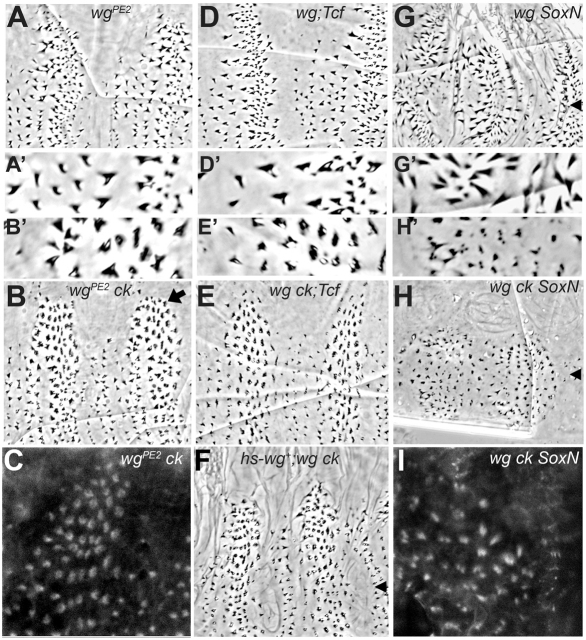Fig. 4.
Intermediate Wg levels alter the appearance of ck mutant denticles. (A) wgPE2 homozygotes have sufficient Wg activity to generate diverse denticle types, but not naked cuticle. (A′) Enlarged view of denticles from A. (B) Denticles in anterior rows of wgPE2 ckKT9 segmental belts are pointed and hooked, but larger denticles in posterior rows remain rounded and appear fragmented (enlarged in B′), particularly along the dorsolateral edge (at top, arrow). (C) Rhodamine phalloidin staining of 14-hour AEL embryos shows ring-shaped actin structures that correlate with fragmentation in the dorsolateral epidermal cells. (D) wgCX4;Tcf2 double mutants restore denticle diversity to the wg phenotype (enlarged in D′), but without positive pathway activation by Tcf, naked cuticle cannot be specified. (E) In wgCX4ckKT9;Tcf2 triple mutants, smaller anterior denticles can acquire sharp points, but larger posterior denticles remain rounded and some appear fragmented (enlarged in E′). (F) The wgCX4 ckKT9 mutant phenotype can be partially rescued by uniform wild-type wg from a heat-shock-promoter-driven transgene. Under these conditions, smaller anterior denticles are more completely rescued than larger posterior denticles. Arrowheads in F-H mark the ventral midline. (G) wgCX4 SoxNNC14 double mutants restore some segmentation to the wgCX4 mutant pattern. (H) wgCX4ckKT9SoxNNC14 triple mutants show a dramatic reduction in denticle size and many of the denticles are fragmented into two or more short projections (compare G′ with H′). (I) Rhodamine phalloidin staining of wgCX4ckKT9SoxNNC14 triple mutants shows that apical actin filaments aggregate abnormally into multiple bundles.

